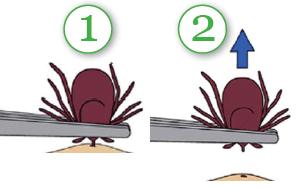Prevention of Tickborne Disease
Ticks do not jump, fly or fall out of trees. They wait on low growing plants for a host (person or animal) to pass by. When a host brushes against the plant, the tick will cling to fur or clothing. Once on the host, the tick will crawl upward, looking for a place to attach and begin feeding. In Arkansas, ticks can be active year around. Reduce the risk of getting disease from ticks by following these steps:
Humans
- Avoid tick-infested areas such as tall grass and dense vegetation.
- Tuck your pants into sock tops or boots.
- Wear light-colored clothing to make it easier to find crawling ticks.
- Use repellents and follow label instructions carefully.
- Check yourself, your children and pets often for ticks.
- Bathe or shower within two hours after being where ticks live to find and wash off ticks that may be crawling on you.
Pets
- Pets are also at risk for tick-borne diseases and can carry infected ticks into the home. However, infected pets cannot spread illness to humans.
- Keep yards and outdoor play areas well mowed to keep away ticks.
- Ask your veterinarian how to control ticks on dogs and cats and always follow any label instructions.
- Inspect pets for ticks often.
Tick Removal
A tick attached to skin should be removed as soon as possible. This is important because disease will not transmit until the tick has been attached for several hours. To remove a tick, follow these steps:
- Use clean, fine-tipped tweezers to grasp the tick as close to the skin’s surface as possible.
- Pull upward with steady, even pressure. Do not twist or jerk the tick; this can cause the mouth-parts to break off and remain in the skin. If this happens, remove the mouth-parts with tweezers. If the mouth cannot be easily removed with clean tweezers, leave it alone and let the skin heal.
- After removing the tick, thoroughly clean the bite area and wash your hands with rubbing alcohol, an iodine scrub, or soap and water.
Do not use home remedies such as “painting” the tick with nail polish or petroleum jelly, or using heat to make the tick come off. The goal is to remove the tick as quickly as possible. Do not wait for the tick to let go!
If you develop a rash or fever within several weeks of removing a tick, see your doctor. Be sure to tell the doctor about your recent tick bite, when the bite occurred, and where you most likely acquired the tick.


